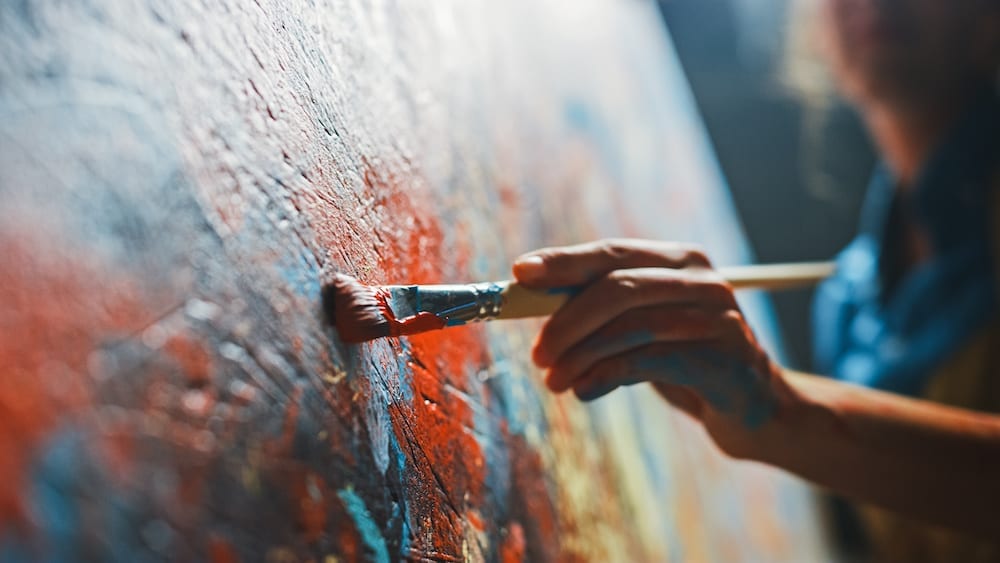An August 2020 exhibition at Post Pilgrim Gallery in Sioux Falls, South Dakota, featured over 25 pieces created by artists combating drug and alcohol addiction. The gallery, dedicated to amplifying the voices of the Native community of South Dakota, also provides an outlet for members of Sioux Falls and the surrounding areas to share their stories. Art allows us to connect with other people and enrich our relationships with ourselves. Through creative production, individuals in recovery can explore the depth of their emotions and, in the process, find control in their lives.
Can Making Art Help Your Mental Health?
The healing properties of art production are what popularized the practice as a treatment for individuals with Alzheimer’s disease, post-traumatic stress disorder (PTSD), anxiety, substance use disorder (SUD), and other psychological conditions. The Harvard Health Blog reports that art production “can relieve stress, aid communication, and help arrest cognitive decline.” By offering a creative outlet, licensed art therapists afford their patients a space to express their emotions. Subconscious feelings may also arise during the creation of a piece. Through the production of art, individuals can reclaim autonomy over their emotions and experiences. With control comes confidence.
How Is Making Art at Home Different From Art Therapy?
Art therapy can take many forms: painting, drawing, sculpting, and graphic design are several formats common to treatment programs across the country. A licensed art therapist facilitates sessions, guiding participants through the creative process. Most programs offer classes with multiple participants led by one or two therapists.
Art production at home is a freeform, individual process. You can choose your preferred medium, whether that be two-dimensional, multimedia, digital, musical, or performance art. You may need to consult your local art supplies store to determine which materials you need and which space in your home to reserve as studio space, but, once equipped with the right tools, you are ready to start making art on your own!
Even though your creative process is unaided by the guidance of a therapist, your artwork can draw from your experiences with SUD or AUD and retain therapeutic benefits. Your journey through substance abuse and recovery is a limitless resource for artistic inspiration. You do not, however, have to create pieces that are reflective of your experiences with mental and emotional health. In your studio, you decide what you want to create. Maybe a butterfly outside the window would make the perfect photograph to hang above the kitchen table. Perhaps your favorite pair of socks look like they could use some funky embroidery around the soles. All creative output is art so long as the process and the product spark some joy.
What Steps Should I Take if I Want to Exhibit my Art in a Gallery?
If you are looking to enter pieces into an exhibition space like the Post Pilgrim Gallery, check out your local arts scene. Commercial, Co-Op and Artist-Run, and Rental Galleries all provide opportunities for emerging artists to enter their work.
Commercial Galleries: Commercial galleries are the most exclusive of the group. Some only accept established artists, whereas others welcome new artists to join their ranks. These galleries may require their artists to sell their art exclusively through the gallery. If you are interested in pursuing art as a career, this type of gallery is best suited for your ambitions.
Co-Op and Artist-Run Galleries: Co-Op Galleries are run by the artists who exhibit in the space. Often, interested artists display their work to a jury who votes to accept or reject the artist. These galleries usually require a fee, such as a membership or commission fee, and other services like “studio watching,” or working at the gallery. If you are looking for a community of passionate local artists, this gallery is right for you
Show Your True Colors By Channeling Your Inner Artist
The arts have long held a vital place at the center of addiction treatment and recovery. Some treatment professionals and programs incorporate art therapy as a tool for their clients. The result is that clients have an excellent, non-traditional means of communication with others, including staff and peers. Participating in an official art therapy program with a trained clinician is one route to take, but creating art can be done without a formal curriculum. It’s easy to assemble art supplies to use at home and work at your own pace. A host of stores, including many online, provide tools needed for drawing, painting, sculpting, ceramics, and other artistic ways to express yourself. Some of the benefits of using art therapeutically include the ability to:
- Explore your emotions
- Express your feelings
- Cope with stress
- Lower anxiety levels
- Develop self-awareness
- Bring out your creative side
- Improve sensory-motor function
- Enhance social skills
Art therapy done by a professional therapist can offer many perks to someone suffering from a mental health disorder but incorporating an informal art program on your own also has its benefits. The act of drawing, painting, sculpting, doing ceramics, and even using coloring books helps people identify and express their emotions while relieving stress and anxiety. At Silver Lining Recovery, we understand the difficulties of managing your mental health. We offer several treatment modalities to fit your needs. We work around your schedule with both day and evening appointment options, including individual and group therapy, couples counseling, 12-step programs, and trauma-based counseling. Our team of experts is ready to help you put together a plan to manage your mental health needs, lower your stress levels, and begin the new year with excitement and confidence about your future. Call us now and find out how to get started! (866) 448-4563

